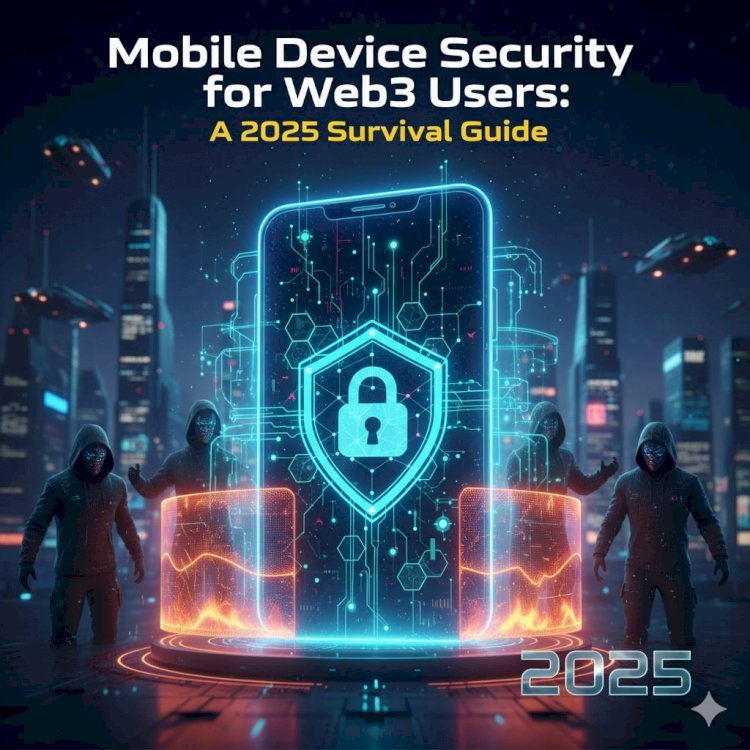Mobile Device Security for Web3 Users: A 2025 Survival Guide

By Dr. Pooyan Ghamari, Swiss Economist and Visionary
In 2025, Web3 has evolved from a niche experiment into the backbone of decentralized finance, digital identity, and ownership economies. Billions of dollars flow through mobile wallets, NFTs live in phone galleries, and DAOs convene via push notifications. Yet the same device that grants you sovereignty over your assets is also the weakest link in your security chain. A single compromised smartphone can drain a lifetime of holdings in seconds. This guide distills battle-tested principles into actionable steps, so your mobile remains a fortress, not a liability.
The New Attack Surface
Mobile threats have matured alongside Web3. Seed-phrase scrapers masquerade as DeFi yield optimizers. Deepfake voice clones impersonate support agents. 5G side-channel leaks expose keystrokes through power fluctuations. Even trusted app stores now host “update” packages that inject silent transaction approvals. The adversary is no longer a script kiddie in a basement; it’s a state-grade lab with a budget larger than most protocols’ TVL.
Your phone is the new bank vault, and the combination is tattooed on the inside of your eyelid.
Hardware Is Your First Religion
Start with the chassis. Use devices that allow bootloader locking and verified boot. Pixels with Titan M2, iPhones with Secure Enclave, or GrapheneOS-loaded Fairphones give you cryptographic roots of trust that generic Android forks cannot. Disable USB data transfer when the screen is locked; a $12 Juice Jack at a conference charging station should never read your keystore.
Enable full-disk encryption and set a firmware password if your hardware supports it. Biometrics are convenient but not secret—store nothing critical behind a fingerprint alone. Pair face or pin with a strong alphanumeric passphrase changed every 90 days.
Software Hygiene Without the Theater
Run only the operating system versions still receiving security patches. In 2025 that means iOS 18.x or Android 15 with GrapheneOS or CalyxOS for the paranoid. Stock ROMs from carriers are riddled with pre-installed telemetry; flash a clean build and verify the SHA-256 yourself.
App installation is now a governance decision. Use minimalist app stores like F-Droid or Aurora. Before sideloading, isolate the APK in Shelter or Insular, grant zero permissions, and monitor runtime behavior with NetGuard. If an app requests “overlay” rights, assume it wants to phish your seed entry.
Wallet Architecture: Compartmentalize or Die
Never store high-value seeds on the same device you use for Twitter and TikTok. Adopt a 2-device model:
- Hot phone: Daily driver for social, email, light DeFi (<5% of portfolio).
- Cold vault: Burner-grade phone kept offline, biometric-locked, used only for signing large transactions via QR codes.
Export watch-only wallets to the hot phone. Sign with the cold vault over air-gapped QR or NFC. Tools like Keystone or NGRAVE Zero now fit in a wallet and pair with mobile apps without ever exposing the seed.
Multi-sig is no longer optional. Require 2-of-3 confirmations where one key lives on the cold vault, one in a hardware module, and one with a trusted multisig coordinator (not an exchange). This turns a single device compromise into an inconvenience rather than a catastrophe.
Network Discipline
Public Wi-Fi is a surveillance net. Route all traffic through a reputable VPN with post-quantum encryption—WireGuard with Kyber is table stakes. Better yet, run your own Tailscale or Headscale mesh so your devices speak only to each other.
Disable Bluetooth when not pairing known peripherals. Ultrasound cross-device tracking is real; silence the beacons. Turn off “Find My Device” location sharing unless you accept Google or Apple as co-signers on your opsec.
Social Engineering Countermeasures
The human stack is still the softest target. Train yourself to slow down:
- Pause on urgency — No legitimate protocol will pressure you into signing within 60 seconds.
- Verify off-chain — DMs can be spoofed; move to an encrypted channel you initiated.
- Read the payload — Blind-signing is Russian roulette. Use wallet apps that pretty-print contract interactions in plain language.
Enable transaction simulation sandboxes. Wallets like Rabby or Zerion now let you preview state changes before broadcast. If the simulation shows an approval to 0x000…dead, walk away.
Backup and Recovery Without Single Points of Failure
Paper backups rot, get lost, or burn. Use metal-plate seed engraving stored in geographically separated safety deposit boxes. Split Shamir secrets across three titanium capsules—two needed to reconstruct. Never photograph the plates; OCR defeats the purpose.
For digital redundancy, encrypt split shares with age and upload to IPFS pinned by at least three independent providers. Retrieve only over Tor with a pre-shared key. Test recovery quarterly; entropy decays faster than you think.
Incident Response Playbook
Detection is better than reaction, but prepare anyway:
- Freeze: Revoke all approvals via Etherscan’s token approval tool or Revoke.cash.
- Isolate: Factory reset the hot phone after imaging storage for forensics.
- Rotate: Generate new seeds on air-gapped hardware; migrate liquidity in small batches.
- Report: Alert the protocol’s immune system—many now offer bug bounties for drain forensics.
The Mindset Pillar
Security is not a product; it’s a process. Treat every notification as a potential phishing lure, every “free airdrop” as a trap, every unsolicited DM as social engineering. The moment convenience outweighs paranoia, you’ve already lost.
Web3 promised you custody of your wealth. In 2025, that promise is kept only by those who treat their mobile device as a nuclear launch console—because in financial terms, it is.
Stay sovereign. Stay vigilant.
Dr. Pooyan Ghamari Swiss Economist and Visionary

 content-team
content-team 


















